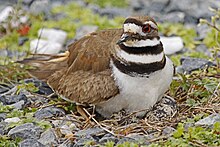Charadrius
| Charadrius | |
|---|---|

| |
| Killdeer (Charadrius vociferus) | |
| Scientific classification | |
| Kingdom: | Animalia |
| Phylum: | Chordata |
| Class: | Aves |
| Order: | Charadriiformes |
| Family: | Charadriidae |
| Subfamily: | Charadriinae |
| Genus: | Charadrius Linnaeus, 1758 |
| Type species | |
| Charadrius hiaticula (common ringed plover) Linnaeus, 1758
| |
| Species | |
|
See text | |
| Synonyms | |
|
Aegialites / Aegialitis | |
Charadrius is a genus of plovers, a group of wading birds. The genus name Charadrius is a Late Latin word for a yellowish bird mentioned in the fourth-century Vulgate. They are found throughout the world.
Many Charadrius species are characterised by breast bands or collars. These can be (in the adult) complete bands (ringed, semipalmated, little ringed, long-billed), double or triple bands (killdeer, three-banded, Forbes', two-banded, double-banded) or partial collars (Kentish, piping, snowy, Malaysian, Javan, red-capped, puna).
They have relatively short bills and feed mainly on insects, worms or other invertebrates, depending on habitat, which are obtained by a run-and-pause technique, rather than the steady probing of some other wader groups. They hunt by sight, rather than by feel as do longer-billed waders like snipe.
Species of the genus Aegialites (or Aegialitis) are now subsumed within Charadrius.
Taxonomy[]
The genus Charadrius was introduced in 1758 by the Swedish naturalist Carl Linnaeus in 1758 in the tenth edition of his Systema Naturae.[1] The name had been used (as Charadrios sive Hiaticula) by the Italian naturalist Ulisse Aldrovandi in 1603 for the common ringed plover.[2] The word is Late Latin and is mentioned in the Vulgate Bible. It derives from the Ancient Greek χαραδριος/kharadrios, an unidentified plain-coloured nocturnal bird that was found in ravines and river valleys (from kharadra, "ravine").[a][4] The type species is the common ringed plover.[5]
Species[]
The genus contains 32 species.[6]
- New Zealand dotterel, red-breasted plover or New Zealand plover, Charadrius obscurus
- Common ringed plover, Charadrius hiaticula
- Semipalmated plover, Charadrius semipalmatus
- Long-billed plover, Charadrius placidus
- Little ringed plover, Charadrius dubius
- Wilson's plover, Charadrius wilsonia
- Killdeer, Charadrius vociferus
- Piping plover, Charadrius melodus
- Madagascar plover, Charadrius thoracicus
- Kittlitz's plover, Charadrius pecuarius
- Saint Helena plover, Charadrius sanctaehelenae
- Three-banded plover, Charadrius tricollaris
- Forbes's plover, Charadrius forbesi
- Kentish plover, Charadrius alexandrinus
- White-faced plover, Charadrius dealbatus
- Snowy plover, Charadrius nivosus
- Javan plover, Charadrius javanicus
- White-fronted plover, Charadrius marginatus
- Red-capped plover, Charadrius ruficapillus
- Malaysian plover, Charadrius peronii
- Chestnut-banded plover, Charadrius pallidus
- Collared plover, Charadrius collaris
- Puna plover, Charadrius alticola
- Double-banded plover or banded dotterel (New Zealand), Charadrius bicinctus
- Two-banded plover, Charadrius falklandicus
- Lesser sand plover, Charadrius mongolus
- Greater sand plover, Charadrius leschenaultii
- Caspian plover, Charadrius asiaticus
- Oriental plover, Charadrius veredus
- Eurasian dotterel, Charadrius morinellus
- Rufous-chested plover, Charadrius modestus
- Mountain plover, Charadrius montanus
In December 2020, it was described in a paper that the Kentish plover subspecies C.a.seebohmi may be a new species, the Hanuman plover.
Gallery[]

Kentish plover (C. alexandrinus)

Semipalmated plover (C. semipalmatus)

Three-banded plover (C. tricollaris) eggs on open ground

Little ringed plover (C. dubius) chick
Notes[]
References[]
- ^ Linnaeus, Carl (1758). Systema Naturae per regna tria naturae, secundum classes, ordines, genera, species, cum characteribus, differentiis, synonymis, locis (in Latin). Volume 1 (10th ed.). Holmiae (Stockholm): Laurentii Salvii. p. 150.
|volume=has extra text (help) - ^ Aldrovandi, Ulisse (1599). Vlyssis Aldrovandi philosophi ac medici Bononiensis historiam naturalem in gymnasio Bononiensi profitentis, Ornithologiae (in Latin). Volume 1. Bononiae (Bologna, Italy): Franciscum de Franciscis Senensem. pp. 536–537, Lib. 20 Cap. 67.
|volume=has extra text (help) - ^ Anonymous (1592). Biblia sacra vulgatae editionis (in Latin). Rome: Ex. Typographica Apostolica Vaticana. p. 92, Leviticus Chapter 11 Verse 19.
- ^ Jobling, James A. (2010). The Helm Dictionary of Scientific Bird Names. London: Christopher Helm. p. 99. ISBN 978-1-4081-2501-4.
- ^ Peters, James Lee, ed. (1934). Check-List of Birds of the World. Volume 2. Cambridge, Massachusetts: Harvard University Press. p. 245.
|volume=has extra text (help) - ^ Gill, Frank; Donsker, David; Rasmussen, Pamela, eds. (July 2021). "Buttonquail, thick-knees, sheathbills, plovers, oystercatchers, stilts, painted-snipes, jacanas, Plains-wanderer, seedsnipes". IOC World Bird List Version 11.2. International Ornithologists' Union. Retrieved 17 August 2021.
| Wikimedia Commons has media related to Charadrius. |
- Charadrius
- Bird genera



